Opposite the Glass
| May 25, 2021Justice Gavriel Bach relives his prosecution of Adolf Eichmann

It was May of 1960, and Prime Minister David Ben Gurion has just made the shocking announcement that Nazi arch-criminal Adolf Eichmann had been captured by the Mossad and brought to Israel for trial. Days later, a young jurist named Gavriel Bach was given an assignment that would forever change his life.
Bach was a lawyer in the State Prosecutor’s office when the chief architect of Adolf Hitler’s “Final Solution” to exterminate Europe’s Jews was seized by Israeli secret agents in Argentina. And a year later — 60 years ago this month — as the Eichmann trial got underway and Israelis finally confronted the enormity of the atrocities buried deep in survivors’ souls for over 15 years, it was Gavriel Bach who took center stage.
The 94-year-old retired Supreme Court justice remembers the phone call from Israeli Justice Minister Pinchas Rosen soon after Eichmann’s capture. Rosen asked that the German-born Bach serve as deputy prosecutor in the case under attorney general Gideon Hausner, but had another request as well — that he be in charge of the entire pre-trial investigation. And there was something else too: For the coming months, Bach would serve as the liaison between the arch-murderer and the outside.
Around the world, millions waited for the trial with bated breath. The staggering agony of the Holocaust, which survivors until then were reluctant to speak about, especially in Israel where “non-heroic” survivors (those who weren’t partisans or didn’t participate in resistance operations) were treated with scorn and derision — suddenly exploded with unfathomable pain. The long, tortuous trial period during the summer of 1961 was perhaps the first psychological attempt for Israeli society, as a collective, to process the horror.
Especially the Children
Bach, who agreed to take the mission, was a natural choice. He was fluent in German and had already proven himself as a top-notch jurist in several high-profile cases over the previous decade, including the famous Kastner trial of the 1950s, in which government employee and former Hungarian community leader Rudolf Kastner was accused of being a Nazi collaborator and judged for having “sold his soul to the devil.”
And so, Bach packed his bags, parted from his wife, Ruth, and two children — two-and-a half-year-old daughter Orly and one-year-old son Yonatan — and spent the next nine months as the legal advisor to Bureau 06 of the Israel Police, which was set up to assemble the evidence against Eichmann. They worked out of Al Jalameh Prison outside Haifa, which had been cleared of its occupants, re-fenced, and provided with tight security, and began to research and amass documents from all over the world in preparation for the trial.
It wasn’t easy. The horrific material Bach encountered gave him no peace for years to come, and the isolation from his family was difficult. He could return home for weekends, but even then, his heart and mind were still filled with the scenes and documents he had viewed throughout the week.
And he’ll never forget his first encounter with Eichmann himself. As part of his duties, Bach liaised between Eichmann and the outside world. If the prisoner had a request, he was to inform Bach.
“That morning,” Bach remembers, “I was in my office reading an autobiography written by one of the most heinous murders, Rudolf Franz Höss, the commander of Auschwitz. Höss was apprehended after the war, put on trial in Poland, and executed by hanging in 1947 inside the Auschwitz camp. He spent his final days writing memoirs.
“So here I was, reading a passage where Höss described killing about a thousand Jewish children a day, but admitted that even for him, sometimes it was too much. ‘Sometimes,’ he described, ‘I felt weak-kneed.’ But there was one thing that made him rally: ‘After I spoke to Obersturmbannführer Eichmann, he explained to me that it was especially important to kill the children. It makes no sense to kill only adults and then to leave alive a generation of avengers, Eichmann explained.’
“As I was trying to digest what I had just read,” Justice Bach recalls, “I suddenly received a message: Eichmann wants to see you.
“When I heard his footsteps in the corridor as he was led to my office, for a moment I saw myself as a little child standing with my family on the platform at Auschwitz.”
He remembers how Eichmann, henchman that he was, always remained a German gentleman. He always tried to be polite, and every time he’d encounter Bach, he would stand at attention.
Oops! We could not locate your form.













